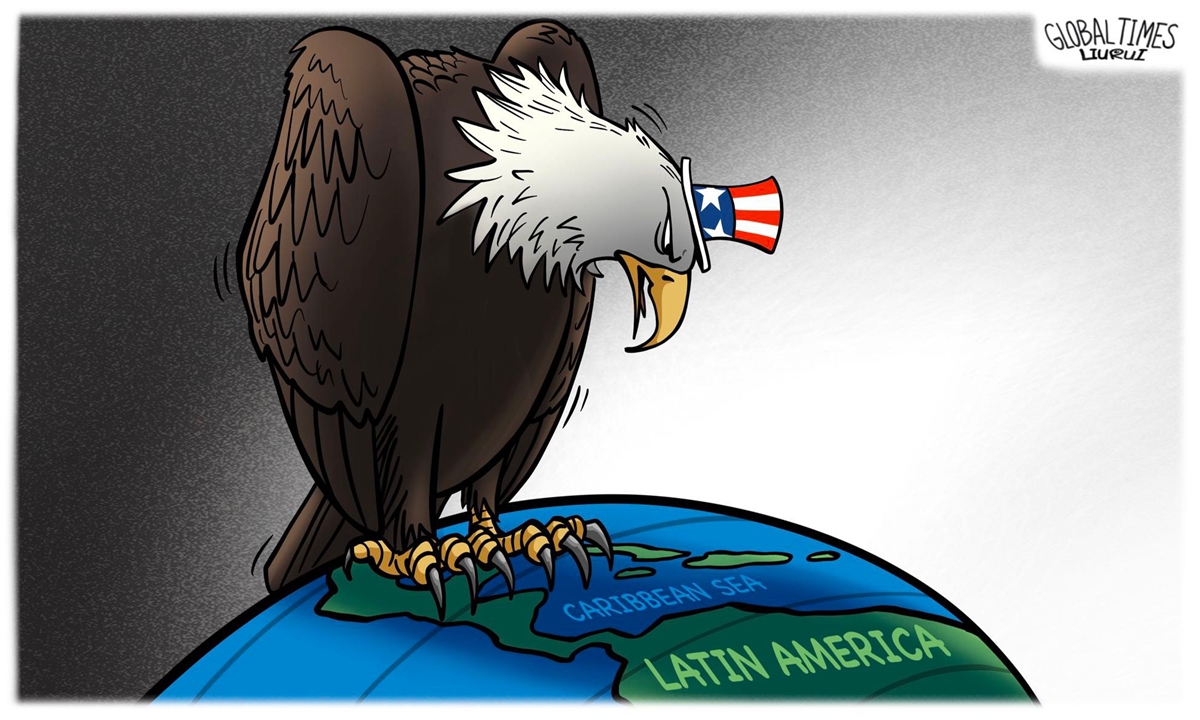The epochal changes we are witnessing primarily entail the redefinition of geopolitical — and consequently, all other — relations. The global hegemon, the United States, which after its Cold War victory insisted that it “has interests in every corner of the planet,” is now clearly being forced to step down from the world throne.
It is almost taken for granted, however, that it will at least retain dominance throughout the entire Western Hemisphere. And not only over the double American landmass — stretching from Alaska’s Barrow Cape and Canada’s Ellesmere Island in the north, to Cape Horn at the southern tip of Tierra del Fuego and the Drake Passage — but also extending roughly to the midlines of the Atlantic and Pacific meridians.
In this context, U.S. President Donald Trump was unambiguous, “stamping” these intentions through statements about purchasing Greenland, annexing Canada, taking control of the Panama Canal… and who knows what else the United States has set its sights on. But will it really be that way?
FROM TELLUROCRATIC TO THALASSOCRATIC PHASE
It is well known that the United States, through the Monroe Doctrine of 1823 and the slogan “America for Americans,” built upon a continental, tellurocratic geopolitical identity, defining its aspiration to turn the American landmass into its exclusive “domain.” This did not simply mean pushing out the European colonial powers — already weakened by the 19th century — but, in terms of classical geopolitical concepts, creating an American pan-region.
Said — and done. First came the genocidal destruction of the native population and the seizure of their lands, including expansion into the so-called Wild West. Then, through purchase and conquest, the U.S. further shaped its territory and, during and after the Civil War, gave political form to a gigantic state. In freer interpretation, it was the realization of a European — and, as history would show, distinctly British — transatlantic imperial project. Positioned “from ocean to ocean,” the U.S., as a kind of “macro-island,” was naturally protected from competing powers of the Old World.
By the end of the 19th century, as the land-based phase of expansion came to an end, the United States faced a “strategic dilemma.” The Monroe Doctrine had reached its limits, and the passion of the “riders” had exhausted itself in continental conquest. A new geopolitical “grand idea” was needed — and it was found in oceanic expansion: the domination of maritime space as a springboard beyond the American continent and a means of access to other continents, particularly to ensure superiority over the Eurasian “giant,” Russia, and to pursue the ambition of global “omnipresence.”
The shift to the maritime, thalassocratic phase and the formulation of the concept of sea power were theoretically established by Admiral Alfred Thayer Mahan — “the first geopolitician among military writers, and the first military writer among geopoliticians.”
What followed was a century of operationalization: establishing control over the Caribbean, advancing into the Pacific and occupying key islands, constructing and managing the Panama Canal as an indispensable link between the Atlantic and the Pacific — that is, between the eastern and western U.S. coasts. Then, in two world wars — without destruction on its own soil and at relatively low human cost — the U.S. secured two transoceanic macro-bridgeheads on the eastern and western edges of Eurasia. After triumphing in the Cold War, the European bridgehead was significantly expanded at the expense of the post-Soviet space and Russia’s traditional sphere of influence.
And, as “no fire burns until dawn,” after reaching the pinnacle and briefly exercising unrestrained control over the entire world, a downward phase has inevitably followed. Americans now hope — in the worst-case scenario — that this decline will at least stop at their uncontested dominance not only in Anglo-America, but also throughout Latin America, which the United States continues to regard as its “backyard.”

DISORDER IN THE “BACKYARD” AS AN INDICATOR
The experience of the “rise and fall of great powers,” as Paul Kennedy would put it, warns that decline soon consumes the powers themselves — not to mention their diminishing influence in their own immediate spheres of interest. The United States, burdened by accumulated internal problems, now witnesses scenes that were once unimaginable — such as the increasingly frequent deployment of the National Guard in American cities. And that’s to say nothing of the problems it faces, and will continue to face, in maintaining its grip on Latin America. Let us mention only a few examples:
- From demographically explosive and migratory-transit Mexico, the population continues to “boil over” across the Rio Grande. No anti-immigration administrative measure — no wall, barbed-wire fence, police action, or sophisticated border surveillance — can stop it. The ethnic transformation, and everything that follows from it, is irreversibly changing the southern U.S. states, already triggering centrifugal tendencies.
- Cuba and Nicaragua have long been branded by Washington as “rogue states” and “rotten apples in the basket of good ones.” Although they are no longer the “thorn in the eye” they once were, their anti-American stance, ideological orientation, and especially their geographical position — one in the Caribbean, the other on the Central American “isthmus” — continue to obstruct U.S. geopolitical interests.
- Panama, including its canal, is rightly perceived by the U.S. as a strategic nexus combining “connection and integration,” but also “separation and division.” It is a confluence of major geographical entities — in maritime terms, the Atlantic and Pacific basins, and in continental terms, North and South America (though not Anglo and Latin America). Needless to say, Washington’s interest in maintaining control over this “umbilical point” and preventing the intrusion of rival powers (such as China) is self-evident.
- Colombia and its narco-cartels remain, for now, under American oversight, but it is only a matter of time before questions arise: under whose patronage, in whose interests, and to what geopolitical ends might they slip beyond that control?
- Brazil, with its 8.5 million square kilometers and 220 million people, constitutes nearly half of South America in both territory and population. Not only is it a founding member of BRICS — the prosperous economic counterweight to the “collective West” — but it also shows a clear capacity to assume the role of South America’s leading power.
- Argentina, the “most European of Latin American countries,” is politically unstable and often unpredictable, yet it possesses undeniable economic potential and a long-standing animosity toward Great Britain — one that extends to the United States as well.
- In Peru, China has built a mega-port in Chancay, about 60 kilometers north of Lima. This facility will soon become the starting or terminal point for transport corridors crossing the Andes toward the Amazon and the resource-rich interior of Brazil — precisely where Brazilian territory lies closest to the Pacific coast. In effect, Chancay is designed as the “gateway to South America,” serving as a trans-Pacific connection of the Belt and Road Initiative — no longer merely Eurasian, but global in scale.
In other Latin American countries, the American embrace is weakening, and “discipline” is fading. The most painful “pebble in Washington’s shoe” is Venezuela — so painful that the U.S. has deployed substantial military assets toward it and continually threatens armed intervention. The official justification — to “combat narco-trafficking under a corrupt, undemocratic regime in Caracas” — convinces no one. The real motive is not President Nicolás Maduro himself, who succeeded the charismatic Hugo Chávez (in power 1999–2013) and survived a U.S.-backed coup attempt by Juan Guaidó in 2019.
Venezuela is a “large bite to swallow”: with an area of 916,000 square kilometers (10–11 times the size of Serbia), a population of 31 million (4–5 times larger), and a 2,800-kilometer coastline along the Caribbean Sea. It also disputes with its eastern neighbor Guyana the resource-rich territory of Essequibo — rich in oil. And oil is the key word. Venezuela has long been known for its “black gold” deposits, mainly in the basin of Lake Maracaibo — a vast, shallow lagoon in the country’s northwest.
Then, in the plains of the Orinoco River basin — a vast savanna (llanos) lying between the mountain ranges of the Caribbean (Northeastern) Andes and the Guiana Highlands — enormous reserves were discovered. In 2015, the world learned that Venezuela had surpassed Saudi Arabia, becoming the country with the largest proven oil reserves. Indeed, its deposits are estimated at 300 billion barrels (1 barrel = 159 liters). It also possesses the world’s eighth-largest natural gas reserves.
Add to that Venezuela’s deepening military-political ties with Russia, a surge of Chinese investments in its energy sector, and its formal application to join BRICS — and you have more than enough to make Washington’s “mouth water uncontrollably.”





